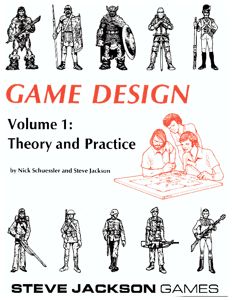...as a general rule, the more factors are explicit (that is, separately represented), the more charts and tables you will have, the more "accurate" your game will be, and the less "playable" it will become. If most factors are implicit, your design will be cleaner, play will be faster... and you will have more of a "game" and less of a "simulation."
Written in 1981, Schuessler and Jackson's Game Design Volume 1: Theory and Practice was compiled mostly from columns and articles that ran in The Space Gamer from 1980-81 and, as related by Jackson himself in the introduction, looks at game design from both the practical and theoretical sides.
As far as the balance between wargaming and role-playing, the bulk of the content is very wargame heavy, with the first 11 chapters covering, among other things, historical backgrounds, mapping and movement, terrain, combat and play sequence and components. Only the 3-pages of chapter 12 (out of the book's total 46 pages + ads in the 1st edition) are solely focused on RPG design. Truthfully, though, less than a decade into the life of RPGs as we know them, many of the role-playing games at the time were obviously founded in the industry's wargames roots, so no faults to mssrs. Schuessler and Jackson.
The real point I'm trying to get to here, though, is what's really contained in the italic lead in to this post, and the reason I think a lot of gamers have moved back to the simplicity of some of the earlier game systems. This is actually reiterated even in the tiny RPG chapter in statements like, "The more detail a character-generation system has, the less manageable and more realistic it will be." The other statement that really seems to hammer my point home is, "D&D, with a combat system so rudimentary as to laughable, has proven immensely popular." (I love that... "laughable.")
In 1981/2 when I was getting into D&D, I bought both the BX boxed sets, as well as the AD&D PH, DMG and MM. But when I DM'ed, I usually DM'ed BX for two reasons: 1) it was simpler for my friends and family to "get" (my sister loved playing elves as a class), and 2) it was simpler for me to run. Now, had I bought the AD&D GM screen and stopped needing to flip through the DM guide constantly, maybe this would have been different. I remember specifically running module U1 under BX, rather than 1E as was intended.
In looking back, I think part of the reason I started to fall away from D&D and started "falling into" games like Marvel Superheroes is because I felt like D&D was getting too "burdensome." I started to feel that way about almost every RPG coming out at the time. There were too many rules. And the books were getting thicker! And there were so many volumes and world books! (To this day, I have an aversion to almost every Palladium book I've ever seen for this very reason!) More importantly, it's why I've been so enamored by and overjoyed with the OSR.
In my day, we didn't have 400-page sourcebooks for every freakin' character sub-class... AND WE LIKED IT!



No comments:
Post a Comment